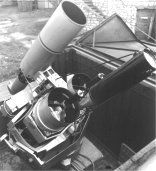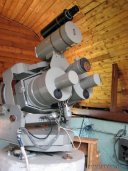SATELLITE LASER
TRACKING IN LATVIA ........
..![]()
The Beginning. At the end of 60 and in the beginning 70 years under the program "INTERKOSMOS" was created working group "Laser rangefinder for satellite". Into working group entered: Hungary, East Germany, Poland, Czechoslovakia and scientists of Soviet Union. Optical system of a telescope, the mechanism of tracking and installation was done of the Astronomical observatory of the Latvian State University, which on that moment already had experience in supervision of satellites and successes in constructions such systems (M.Abele, K.Lapushka). For incomplete two years in 1972 the First Laser Telescope "INTERKOSMOS (LD-1)" which has been installed in Ondřejov Observatory (Czech Republic). There it worked with 1972 till 1975, then was installed in Poznan Astronomical Observatory (Poland).
LD-1 belonged to the first generation of laser rangefinders with measurement of range up to the satellite with accuracy ~ 1.5 - 3.0 m. It was 4-axis setting with analog an electromechanical drive with manual observation of the satellite and an opportunity of correction of a position. A telescope of system Kassegrena with diameter of the main mirror 320 mm. The telescope - guide: a refractor with an entrance aperture of 120 mm. The laser generator worked on the basis of ruby crystal with length of a core 120 mm and diameter 10 mm. The generator made a light pulse in length about 12 nsec with length of a wave 694.3 nm and with capacity of a pulse 100 MW. Radius of action up to 3000 km. |
Second copy in April, 1973 was brought in the Astronomical observatory of the Latvian State University and is established on territories of an observatory of the Latvian State University in the Botanical garden. The laser telescope was put on a special platform which with the help of hydraulic system quickly could lift and lower a laser telescope on the necessary position. Work with this laser range finder has begun laser astrometric era in Latvia. Intensive process of development of installation proceeded up to the end of 1973 when 404 measurements of distance on all coils of satellites "GEOS-A", "GEOS-B" and "BEB" were executed, reaching accuracy 1 m. In the beginning of 1974 this second copy LD-1 was delivered to Egypt, in an observatory in Helwan where began work from September, 1974. Third copy also in 1974 was established near to settlement Patacamaya in Bolivia on plain Altiplana at height of 3874 km above a level of ocean, approximately halfway between cities of La Paz and Oruro. Fourth copy in 1976 has arrived on an observatory in Kavalur (India). The fifth in 1977 on the Cuban observatory of Santiago de Cuba. The sixth on an observatory in Simeiz (Crimea) and the seventh on an observatory in Zvenigorod near Moscow. Scientifics of the Astronomical observatory of the Latvian State University accepted active participation in installation, in operation of these laser rangefinders and in supervision on these tools!
 ... ... |
1979: laser rangefinder LD-2 established in the territory of the Astronomical Observatory of the Latvian State University in the Botanical Garden which also belonged to the First generation of laser rangefinders, but was created, as against model LD-1 was two-channel optical receiver of signals with use of the circuit of concurrence which quickly allowed to reduce quantity noises pulses. The laser generator also was on the basis of ruby crystal, together with all that electronics was placed in installation of a telescope. |
1979: in Riga was made the First Copy of Laser RangeFinder LD-2 and established on territories of the Astronomical observatory of the Latvian State University in the Botanical garden. The First measurements were held June, 7, 1979 from a laser location of satellite "GEOS-3". Initial accuracy of measurement on model LD-2 also was in borders about 1-2 m as the length of a laser pulse was about 20 nsec. Accuracy of measurement of distance up to the satellite of 30 cm which was the best result on measurement of range up to the satellite of that time
Further, these models LD-2 and LD-3 steel does not meet modern requirements determine of the distance to the satellite. First, accuracy of measurement which mainly is limited with length of a pulse about 15 nsec after modernization was limited. Accuracy in borders between 30-50 cm was suitable for exact definition of an orbit of the satellite, but insufficient for use of results in a space geodesy. Second, rather weak optical system did not allow to make laser measurements of range up to satellites on the average far (6000 km) and far (20 000 km) for there was no opportunity visually to see satellite for pointing the laser beam.Thirdly, insufficient accuracy of tracking which was limited analog an electromechanical opportunity of system and which in turn excluded exact observation of far satellites.
New laser rangefinders which had various names : "KRIM", "TPL", "LS-105", were created by a principle " three to one ". It meant, that all three main functions of the rangefinder - the collimation and a deviation of a beam, the receiver of the reflected pulse and a guiding and aiming are realized, using same the main optical system. The main optical system Kassegrena-Kude with diameter of the main mirror 100 cm and with focus of 11.6 m. Mount of a telescope is classical alt-azimutal with stepper motor which speed with very high accuracy are adjusted with computer under the appropriate program. |
The First measurements of distance to the satellite LAGEOS-1 (6000 km) were received September, 9, 1987. Today: an average square-law mistake of measurement of range up to the satellite on border from 0.5 up to 1 cm with a square-law mistake of normal points from 1 up to 2 mm. With laser telescope LS-105 Station Riga takes part in an international research program on satellite laser ranging organization ILRS (International Laser Ranging Service), and in the working program on a laser location of organization EUROLAS (European Laser Ranging Service).
Last Update: March 3, 2017
Material by Igor Abakumov